Yesterday Was A Lie, A Film Review
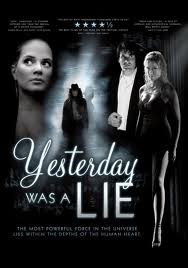 “Yesterday Was A Lie” is an indie film that indulges in experimental exposition right out of the gate.
“Yesterday Was A Lie” is an indie film that indulges in experimental exposition right out of the gate.
The story unfolds in a purposely non-linear fashion, and the unwary viewer can easily lose track of what is happening. The blurbs identifying the film as a “metaphysical mystery” do little to suggest how different is this film from what one might expect a mystery film to be.
The subscriber reviews in Netflix and Blockbuster seemed to generally pan it, although those who gave it five stars mostly did so while not sharing their revelation of what the film is about.
The ‘genius groups’ take seemed to be that one either gets it or one doesn’t get it, and if one doesn’t get it, one won’t understand it in any case. Those of a sub-genius persuasion, and I count myself among them, will very likely benefit from an understanding of the story before seeing the film.
Rather than a spoiler, such knowledge would have helped me to better appreciate on first viewing the weird and innovative crafting that shapes the film.
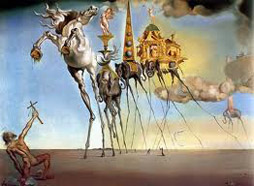 It is not so much the content as the way in which the story is told that defines it; filmed in black & white, using lots of cheesy FX fog and 1940’s period costuming and props, with often intense light and dark, and a time-line that unexpectedly jumps forward and back, it is punctuated with frequent references to Salvador Dali and T.S. Eliot, all of which accentuate the surreal world in which the main character searches for answers.
It is not so much the content as the way in which the story is told that defines it; filmed in black & white, using lots of cheesy FX fog and 1940’s period costuming and props, with often intense light and dark, and a time-line that unexpectedly jumps forward and back, it is punctuated with frequent references to Salvador Dali and T.S. Eliot, all of which accentuate the surreal world in which the main character searches for answers.
Occasionally the viewer is also reminded that he/she (as well as the main character) still belongs to the real world, even while being immersed in the main character’s fantasy world, by the anachronistic appearance of the main character’s laptop computer and digital voice-mail display unit amidst 1940’s technology.
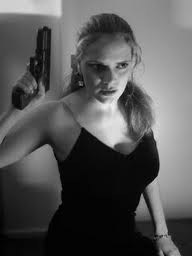
The viewer needs to actively engage this film to keep track of what is happening rather than expect the film to explain itself as it moves along. For those of us who would benefit from an explanation in advance, the following transposition of the plot elements into a linear framework gives only a starting point for experiencing the film.
It opens with the main character, Hoyle (Kipleigh Brown), lying on a couch in the real-world office of her shrink. She’s trying to deal with personal issues following a break-up with her boyfriend, John Dudas (John Newton). She is in a hypnotic trance, during which her shrink is walking her through an effort to identify a ‘mysterious stranger’ in her mind.
The apparent shock of discovering that the ‘stranger’ is possibly herself causes Hoyle to immediately catapult herself into a 1940’s film-noir fantasy world, where she casts herself as a female hardboiled private investigator on the trail of a mysterious notebook. This fantasy trip, in which she ultimately resolves her real-world issue, occupies most of the rest of the film.
In this fantasy world she has cast her ex-boyfriend John as a genius physicist. She believes that his anguish from the breakup has upset the natural order of the universe, and that he believes he will set things right once again by solving complex quantum physics equations.
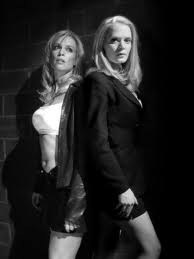 To do this, she believes that he has murdered a mysterious old man (Peter Mayhew) and robbed him of an old notebook that perhaps contains the answers to the equations. She also believes, in this fantasy world, that he will misuse the information in the notebook and actually make things worse. Consequently she spends a lot of effort chasing after John to recover the notebook before he can use it.
To do this, she believes that he has murdered a mysterious old man (Peter Mayhew) and robbed him of an old notebook that perhaps contains the answers to the equations. She also believes, in this fantasy world, that he will misuse the information in the notebook and actually make things worse. Consequently she spends a lot of effort chasing after John to recover the notebook before he can use it.
Early in her sleuthing she comes upon a singer in a nightclub (Chase Masterson) who looks and dresses a lot like Hoyle. The singer, who it seems is the mysterious ‘stranger’ in her mind and is the intuitive, romantic side of Hoyle, offers to help the analytical unromantic private investigator side of Hoyle search for John and the notebook. Eventually private investigator Hoyle catches up with John and the notebook, and with help from singer Hoyle realizes that the notebook is not actually a key to anything.
She has been using her characterization of John and the notebook to try to rationalize genius-John as the cause of the breakup, and finally accepts that she, and not John, was the actual cause; and that it is up to her, rather than him, to set his world right again.
 Singer Hoyle convinces private investigator Hoyle to go back to non-genius John. At the end of the film we see Hoyle back in the real world, dancing once again with John.
Singer Hoyle convinces private investigator Hoyle to go back to non-genius John. At the end of the film we see Hoyle back in the real world, dancing once again with John.
Devotees of Star Trek’s Deep Space Nine television series will remember Chase Masterson as the comely Bajoran dabo girl, Leeta, employed by Ferengi entrepreneur Quark at his bar on the space station and who appeared behind crinkle-nosed makeup in over a dozen DS9 episodes. Here in “Yesterday Was a Lie” she does 1940’s makeup, and gets to wear her hair down and sing her own torch songs within a script 180 degrees away from DS9 scripting.
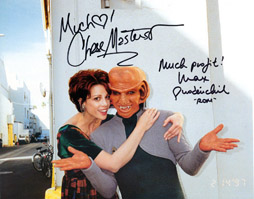 The seemingly melodramatic film-noir acting is there to purposely reflect and support the fantasy world as Hoyle experiences it, even though a viewer lost in the non-linear twists and turns of the plot may think it evidence of pretentious ego boo conceit on the part of the director. Writer/Director James Kerwin walks a fine line here betting that viewers will ultimately distinguish and interpret the clichéd surreal world he’s created for Hoyle against the real world he has created at the very beginning and at the end of the film.
The seemingly melodramatic film-noir acting is there to purposely reflect and support the fantasy world as Hoyle experiences it, even though a viewer lost in the non-linear twists and turns of the plot may think it evidence of pretentious ego boo conceit on the part of the director. Writer/Director James Kerwin walks a fine line here betting that viewers will ultimately distinguish and interpret the clichéd surreal world he’s created for Hoyle against the real world he has created at the very beginning and at the end of the film.
“Yesterday Was A Lie” is a bit of a mindbender.
How many stars a viewer will give it will most likely depend upon how agreeably the viewer believes his/her mind was bent. I gave it one star at the moment that I finished viewing it, but I was piqued enough by its seeming incongruities to actually try to make sense of it, which took me another 24 hours. I got past directorial ‘pretentious ego boo’ and gave it three stars, docking it two stars for writer/directorial conceit that pitched the film to a IQ level high enough to mark me as a sub-genius for the time it took me to figure it out.